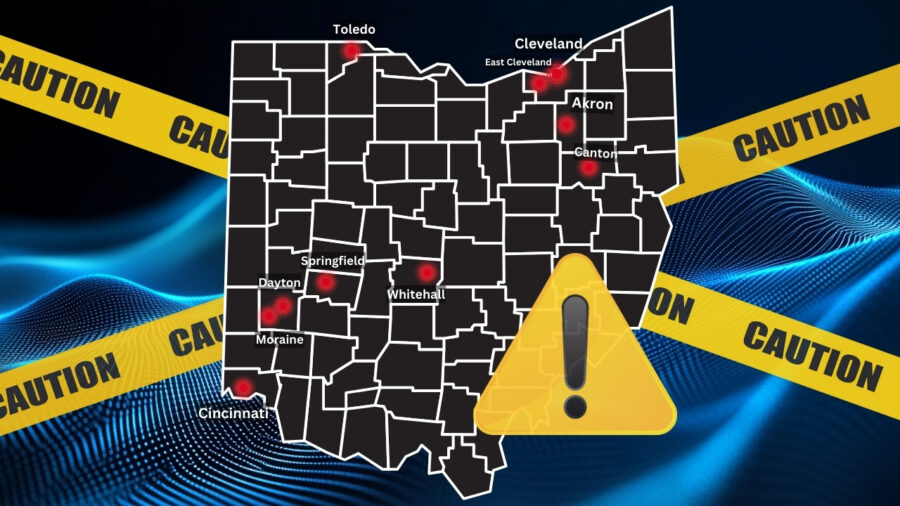Ohio is home to several cities that struggle with high crime rates, making them some of the most dangerous in the state. Crime statistics, including violent offenses like assaults and robberies, paint a clear picture of where these cities stand.
Factors like economic hardship, unemployment, and drug activity often play a significant role in shaping the crime landscape. If we focus on the numbers and get to understand the challenges in these areas, we can identify Ohio’s most dangerous cities and the issues contributing to their crime levels.
Currently, Ohio’s crime rate is at 20.76.
Now, let us check the cities that are the biggest contributors to this number.
| Rank | City | Population | Violent Crimes | Property Crimes | Total Crimes | Chances of Becoming a Victim |
|---|---|---|---|---|---|---|
| 10 | Moraine | 6,393 | 53 | 429 | 482 | 1 in 124 |
| 9 | Akron | 188,509 | 1,548 | 6,465 | 8,013 | 1 in 122 |
| 8 | Cincinnati | 309,513 | 2,597 | 11,747 | 14,344 | 1 in 119 |
| 7 | Whitehall | 18,944 | 171 | 1,212 | 1,383 | 1 in 118 |
| 6 | East Cleveland | 13,219 | 142 | 306 | 448 | 1 in 95 |
| 5 | Toledo | 266,301 | 3,111 | 8,288 | 11,399 | 1 in 86 |
| 4 | Dayton | 135,944 | 1,605 | 5,875 | 7,480 | 1 in 85 |
| 3 | Canton | 69,671 | 827 | 3,887 | 4,714 | 1 in 84 |
| 2 | Springfield | 58,106 | 707 | 2,651 | 3,358 | 1 in 82 |
| 1 | Cleveland | 361,607 | 5,884 | 15,779 | 21,663 | 1 in 61 |
Table of Contents
Toggle10. Moraine – 73.70 per 1000 People
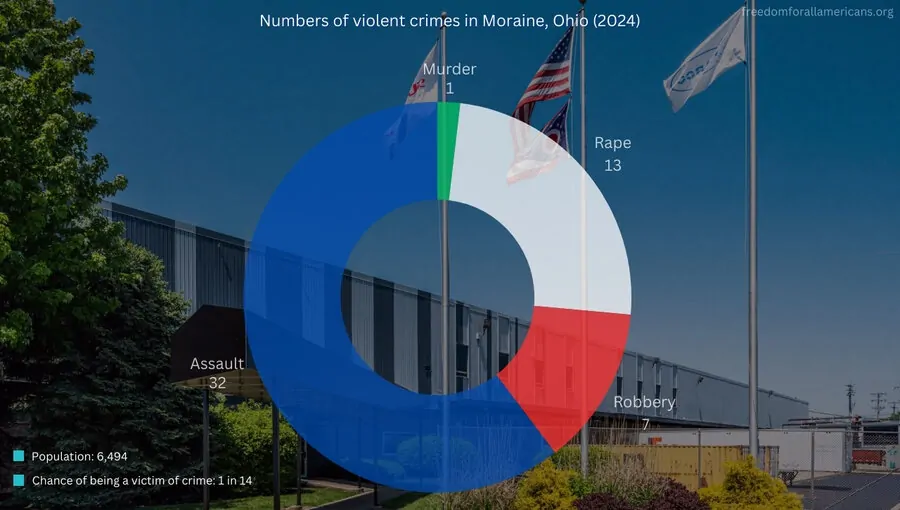
Moraine’s crime rate stands at 73.70 per 1000 people, which makes it the most dangerous city in Ohio.
According to the United States Census Bureau, the population of Morain is just 6,494, and this is the number that clearly shows you how problematic the crime in this city’s crime is.
Moraine’s overall crime rate is alarmingly higher than the national average by 119%, as per AreaVibes stats. At the same time, it is four times higher than the average rate in the state of Ohio crime rate.
- Population: 6,494
- Violent Crimes: 53
- Property Crimes: 429
- Total Crimes: 482
- Chances of Becoming a Victim: 1 in 14
A detailed analysis of the types of crimes prevalent in the area indicates a significant incidence of burglary, car theft, and robberies, often linked to broader social issues within the community. For more details, check out our analysis.
- Burglary: 29
- Theft: 362
- Motor Vehicle Theft: 38
9. Akron – 42.51 per 1000 Population
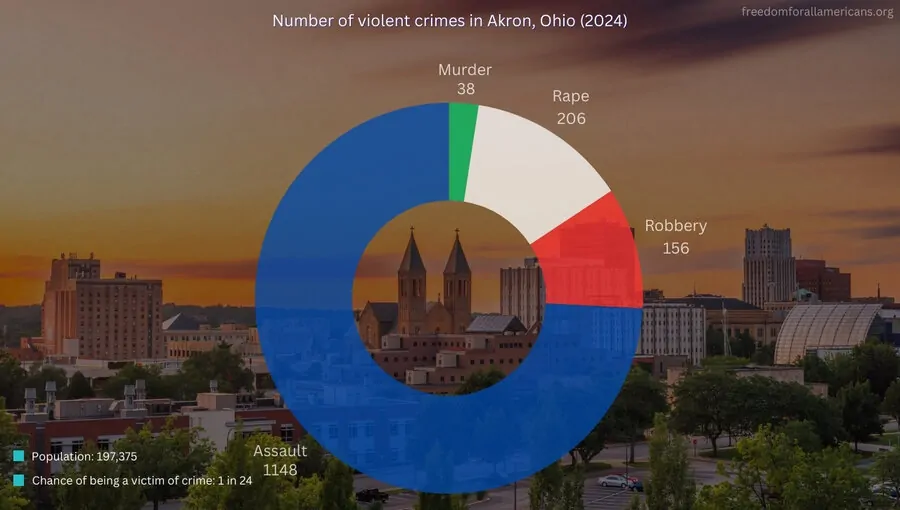
According to NeighborhoodScout, Akron’s crime rate is 42.51 per 1000 population.
The frequency of violent crime incidents is a growing concern, with socio-economic factors playing a critical role. All this led to the forming of a local neighborhood watch in different neighborhoods, Akron.com reports.
- Population: 197,375
- Violent Crimes: 1,548
- Property Crimes: 6,464
- Total Crimes: 8,012
- Chances of Becoming a Victim: 1 in 24
This is fun, it’s what we do to homeless people’s stuff when we do encampment sweeps. If we’re lucky, sometimes we even get to arrest some of them. https://t.co/F6AXWIBkER
— Akron Police Depotartment (@AkronPoliceDp) May 26, 2024
The city struggles with high rates of unemployment and economic disparity, like the whole state of Ohio, which correlate strongly with the incidence of crime.
According to YCharts, the unemployment rate is currently at 5.30%, but we can see that it has increased from the same month the previous year, when it was at 3.70%.
- Burglary: 1,030
- Theft: 4,525
- Motor Vehicle Theft: 909
Complete Murder Statistics for 2024 and Trends In Early 2025
According to WKYC, Akron reported 25 murders in 2024, a slight decrease from 26 in 2023. This continues a downward trend from a peak of 50 murders in 2020.
8. Cincinnati – 45.93 per 1000
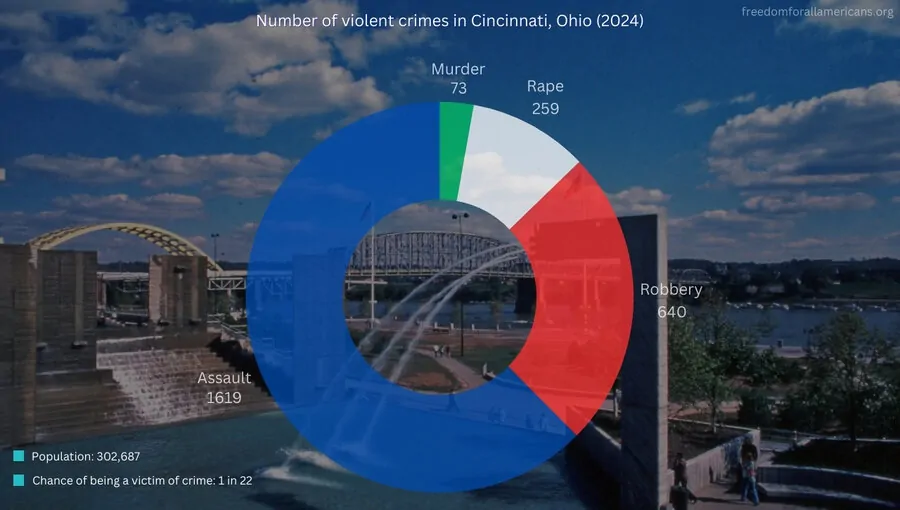
Cincinnati’s violent crime rate, 45.93 per 1000 residents, stands at 187% higher than the national average.
The U.S. Bureau of Labor Statistics shows that the city’s socio-economic conditions, including significant income disparities and unemployment, which is currently at 3.8, fuel much of the crime rates observed.
- Population: 302,687
- Violent Crimes: 2,591
- Property Crimes: 11,543
- Total Crimes: 14,134
- Chances of Becoming a Victim: 1 in 22
D1 is attempting to identify the suspects pictured below. On 7/5/24 the suspects broke into multiple vehicles at 104 W McMillan St. If you have any information, please contact Det. Hert at 513-352-4568. pic.twitter.com/M6H2WpwnDX
— Cincinnati Police Department (@CincyPD) August 7, 2024
Efforts to revitalize economic zones and improve community policing are underway, aiming to mitigate these factors, as per OJP.
- Burglary: 1,877
- Theft: 7,655
- Motor Vehicle Theft: 2,011
Nevertheless, we can see that the locals are hopeful because the crime rate was at an all-time low in 2022, as WVXU reported.
Preliminary Statistics for the Year of 2024
Preliminary data indicates that overall crime in Cincinnati decreased in 2024 compared to 2023. However, violent crimes, including homicides and aggravated assaults, saw an uptick.
According to local12, the city recorded 72 homicides in 2024, a slight increase from 71 in 2023 and equal to the 72 reported in 2022. Aggravated assaults also rose by 11% during the same period.
7. Whitehall – 68.83 per 1000 People
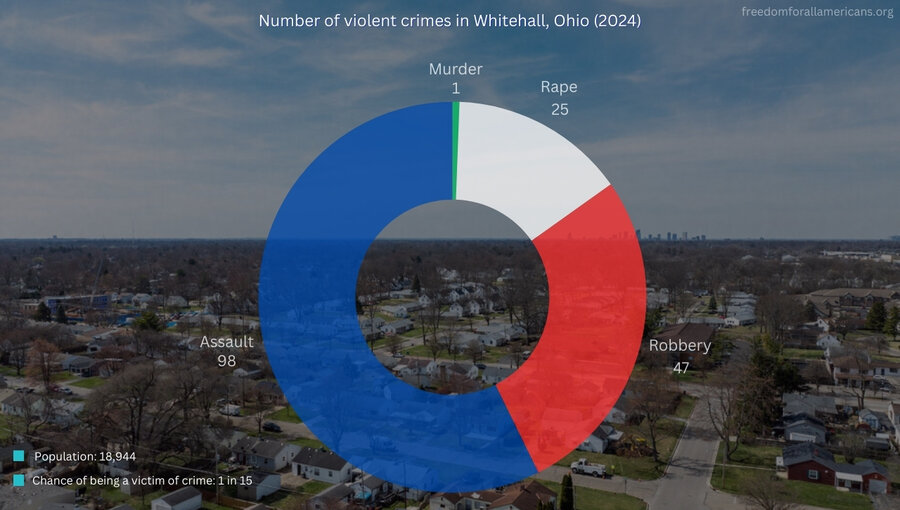
Whitehall’s crime rate is currently at 68.83 per 1000 people.
In Whitehall, the disparity in crime rates across different city parts highlights the uneven economic development and resource distribution, as we can see from AlliedAcademies research.
- Population: 18,944
- Violent Crimes: 171
- Property Crimes: 1,212
- Total Crimes: 1,383
- Chances of Becoming a Victim: 1 in 15
The disparities in crime rates not only highlight the necessity for enhanced security measures but also call for a comprehensive review of economic policies and resource distribution to address the underlying causes of crime.
Do you know this person?
This male was involved in a robbery at a local store. He was described as a male/black, around 5’06”, over 200 lbs. If you know who this person is please contact Det. Mckittrick at 614-246-7428 or email at anthony.mckittrick@whitehall-oh.us pic.twitter.com/MjDU1z9yV1
— Whitehall Police (@WhitehallPD) July 25, 2024
- Burglary: 117
- Theft: 964
- Motor Vehicle Theft: 131
According to YMCA Columbus, investments in community policing, youth engagement programs, and economic redevelopment could be vital in stabilizing crime rates and improving the living conditions in Whitehall.
6. East Cleveland – 33.16 per 1000 People
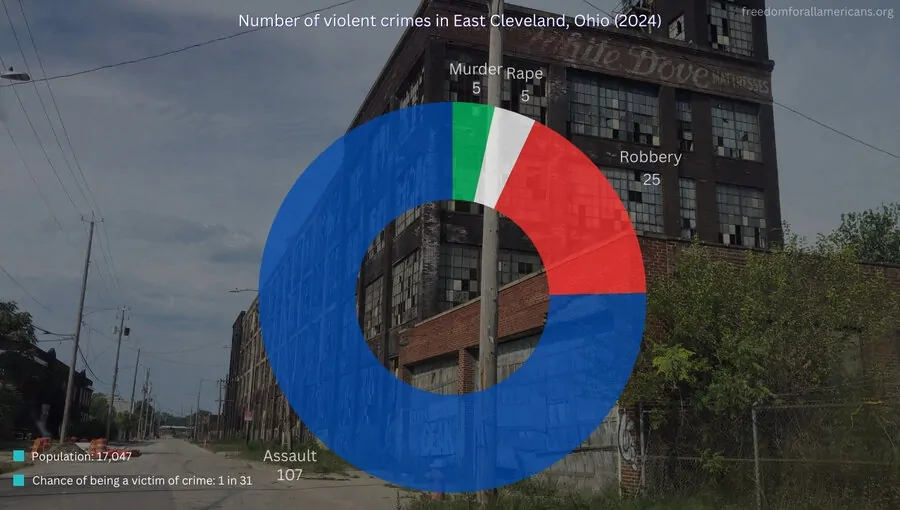
East Cleveland, with a small population of 17,047, struggles with a crime rate that is 260% higher than Ohio’s average, as per statistics. At the moment, its overall East Cleveland crime rate is 33.16.
Investigations into specific neighborhoods reveal significant differences in safety levels.
Some districts are particularly affected by neglect, leading to higher crime rates and visible decay.
- Population: 17,047
- Violent Crimes: 142
- Property Crimes: 303
- Total Crimes: 445
- Chances of Becoming a Victim: 1 in 31
The variance can often be traced back to economic factors, where areas with higher unemployment and lower income levels see more frequent and severe criminal activity.
The city has been actively trying to mitigate these high crime rates through various community programs and law enforcement strategies.
Efforts include increasing police presence, community policing initiatives, and social programs aimed at addressing the root causes of crime, like poverty and unemployment, as Cleveland.com reports.
Safety Plans
Bibb Administration’s Summer Safety Plan in Cleveland resulted in a 37% decrease in murders and an overall 13% reduction in violent crime during the summer months of 2024, according to the City of Cleveland.
5. Toledo – 42.44 per 1000 People
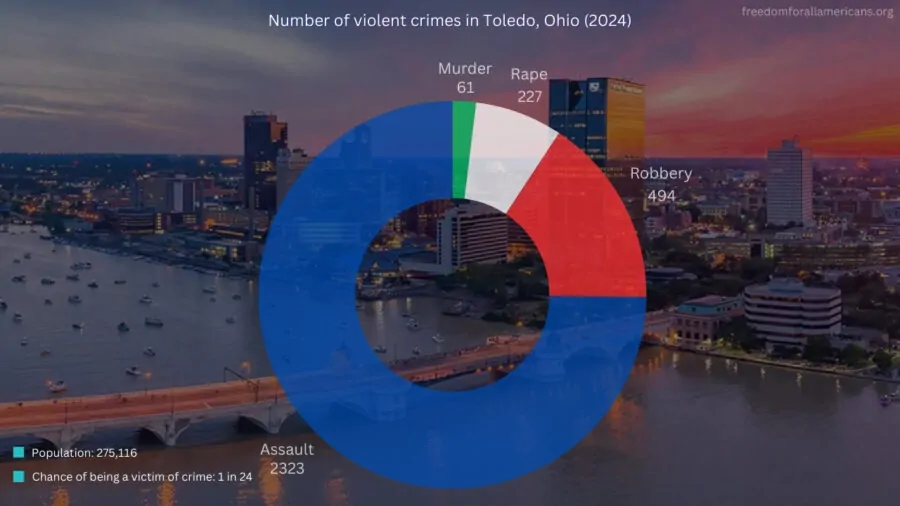
Toledo faces numerous problems, from infrastructure to high unemployment rates. The current unemployment rate is at 5.7, according to FRED Economic Data.
All the factors contribute to the overall crime rate touching 42.44.
Toledo faces complex challenges, with a significant analysis of violent crimes showing a city grappling with economic challenges that contribute to high crime rates.
At the moment, the median salary is $39,811, Talent.com reports.
- Population: 275,116
- Violent Crimes: 3,105
- Property Crimes: 8,225
- Total Crimes: 11,330
- Chances of Becoming a Victim: 1 in 24
Toledo’s economic landscape is a major contributor to its high crime rates.
Areas with higher unemployment rates, economic instability, and lower income levels are more susceptible to frequent and severe criminal activities.
Successful End of 2024 for the City
According to the City of Toledo, during a press conference at the Safety Building, Mayor Wade Kapszukiewicz and Police Chief Michael Troendle presented the 2024 year-end crime statistics, highlighting a notable reduction in crime rates across various categories compared to 2023, including an 18% decrease in homicides.
4. Dayton – 54.57 per 1000 People
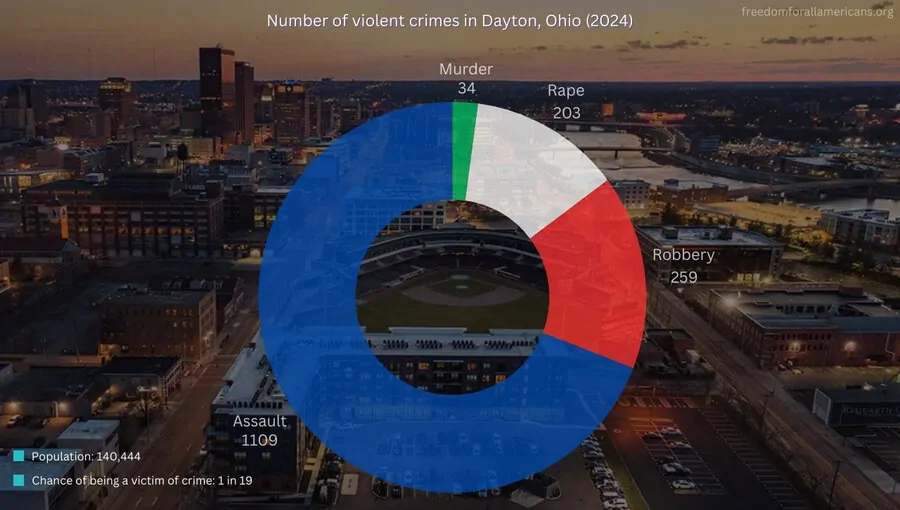
We can see that this is one of the cities where violence has increased the most in the last two decades.
In 2022, it was ranked as the fifth most dangerous city in the United States on WDTN rankings.
The overall crime rate is 54.57 per 1000 people, which is much higher than most of the similar-sized cities in the country.
Dayton’s crime rate, which is 217% higher than the national average, reflects the city’s battle with economic hardships and the drug trade, as per Justice.gov.
The local economy’s downturn has been a fertile ground for crime to flourish, making it a focal point for law enforcement and community initiatives.
- Population: 140,444
- Violent Crimes: 1,605
- Property Crimes: 5,875
- Total Crimes: 7,480
- Chances of Becoming a Victim: 1 in 19
The alarming crime rates in Dayton underscore the urgent need for continued and strengthened efforts by both law enforcement and community organizations. The local Police Department has problems with attracting new recruits, Dayton Daily News reports.
Addressing these challenges requires a combination of proactive policing, community engagement, improved social services, and economic revitalization strategies.
The goal is to not only reduce crime but also address the underlying socio-economic issues that fuel it, ultimately aiming to restore safety and confidence among the residents of Dayton.
- Burglary: 1,339
- Theft: 3,096
- Motor Vehicle Theft: 1,440
The Trend Throughout the Whole 2024
In 2024, Dayton experienced a significant increase in violent crimes, particularly homicides and gun-related incidents.
Dayton Daily News report that the city recorded 44 homicides, a 47% rise from the previous year and the highest number since 2020.
Additionally, gun-related aggravated assaults escalated to 241 incidents, marking an increase over the prior three years.
Robberies also saw an uptick, with 155 cases reported in 2024, representing a 23% increase from 2023.
Aggravated robberies rose by 29% to 201 incidents, while aggravated assaults increased by 6% to 582 cases.
3. Canton – 67.66 per 1000 People
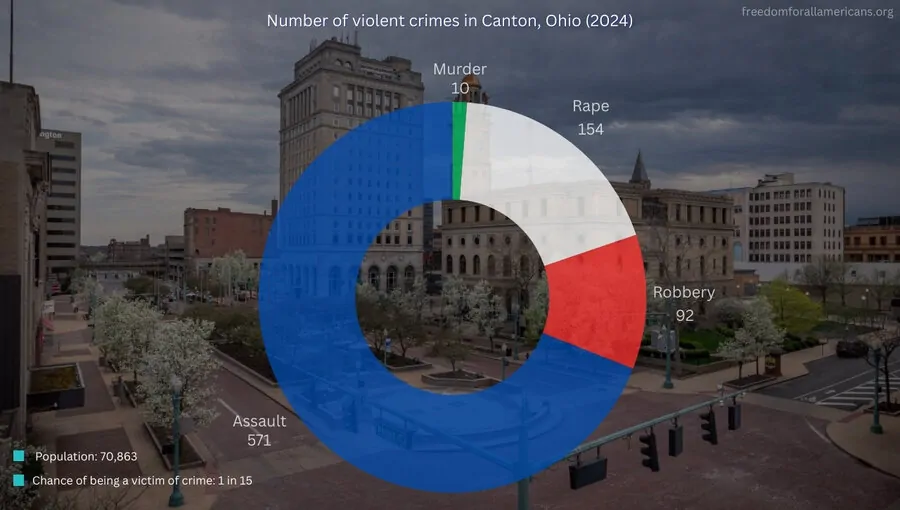
The crime rate has skyrocketed recently and Cantion, Ohio crime rate is at 67.66.
Canton’s detailed statistics reveal a disturbing trend of violent crimes, closely tied to the city’s high unemployment and poverty rates.
Cleveland.com reports that the city experiences:
- Child poverty: 47.4%
- Total poverty: 30.2%
- Population: 70,863
- Violent Crimes: 827
- Property Crimes: 3,887
- Total Crimes: 4,714
- Chances of Becoming a Victim: 1 in 15
Efforts to tackle poverty, improve employment opportunities, and enhance education are essential to mitigate the factors that foster crime.
- Burglary: 602
- Theft: 2,711
- Motor Vehicle Theft: 574
Community-based programs that engage residents in crime prevention and social support services can also play a vital role in transforming the current scenario.
The objective is to create a safer environment in Canton by addressing both the immediate security concerns and the deeper socio-economic issues contributing to the city’s high crime rates. Some steps have been made recently to tackle economic issues, Crain’s Cleveland Business reports.
The high incidence of crime in Canton demands not only robust law enforcement response but also deeper social interventions.
End of 2024 Stats
Recent data indicates a notable decrease in crime rates in Canton, Ohio, during 2024. The city experienced a significant drop in homicides, with only five cases reported, down from 16 in 2023 and 21 in 2021.
As CantonRep reports, both violent and property crimes saw reductions in 2024 compared to the previous year.
However, there was an uptick in domestic violence incidents, which increased by 59 cases, totaling 1,041 in 2024. Robberies also saw a slight increase of 9%, equating to six additional incidents compared to 2023.
2. Springfield – 57.79 per 1000 People
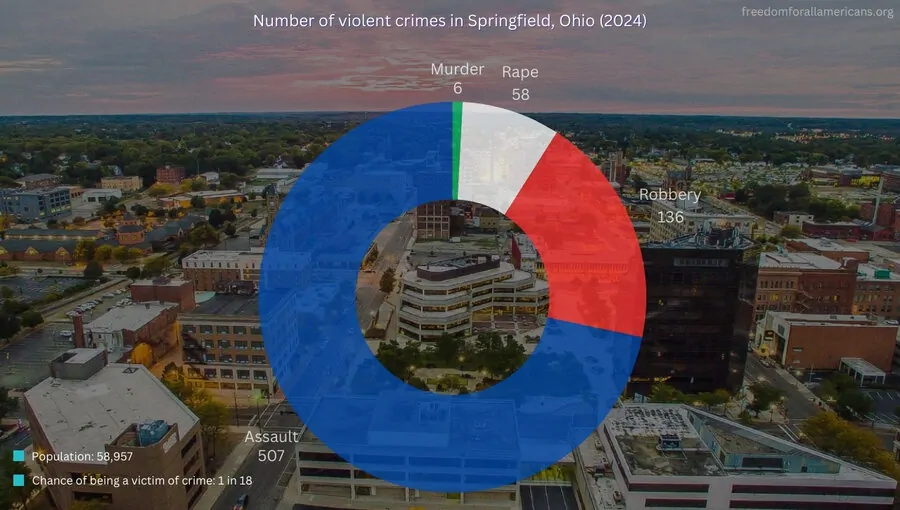
Springfield is the second most dangerous city in Ohio, with a crime rate of 57.79 per 1000 people.
Springfield records a violent crime rate 226% higher than the Ohio average.
- Population: 58,957
- Violent Crimes: 707
- Property Crimes: 2,651
- Total Crimes: 3,358
- Chances of Becoming a Victim: 1 in 18
The pronounced link between Springfield’s economic health and its crime rates suggests that economic revitalization could play a key role in reducing crime.
Interestingly enough, Springfield has a lower unemployment rate than most towns in the region, but the crime persists nevertheless, Dayton Daily News reports.
Numerous efforts have been made to tackle these issues.
Initiatives to boost local employment, improve educational opportunities, and provide economic support can help mitigate the factors that drive individuals toward criminal activity.
According to the City of Springfield, enhancing community policing efforts, increasing the visibility of law enforcement in high-crime areas, and implementing crime prevention programs can help reduce the incidence of both violent and property crimes.
- Burglary: 531
- Theft: 1,765
- Motor Vehicle Theft: 355
Investing in social services such as counseling, substance abuse programs, and youth outreach initiatives can address some of the root causes of crime.
End of 2024 Trends
According to a report by 10TV, data from the Springfield Police Division indicates a gradual increase in crime over recent years.
Specifically, there was approximately a 15% rise in index crimes—which include offenses such as murder, rape, robbery, aggravated assault, burglary, larceny, and motor vehicle theft—from 2021 to 2023. The numbers are as follows:
- 2021: 3,106 index crimes
- 2022: 3,446 index crimes
- 2023: 3,578 index crimes
This increase is primarily attributed to theft-related crimes, including shoplifting and motor vehicle theft. Violent crimes, such as murder, rape, robbery, and aggravated assault, have remained relatively stable during this period.
1. Cleveland – 59.31 per 1000 People
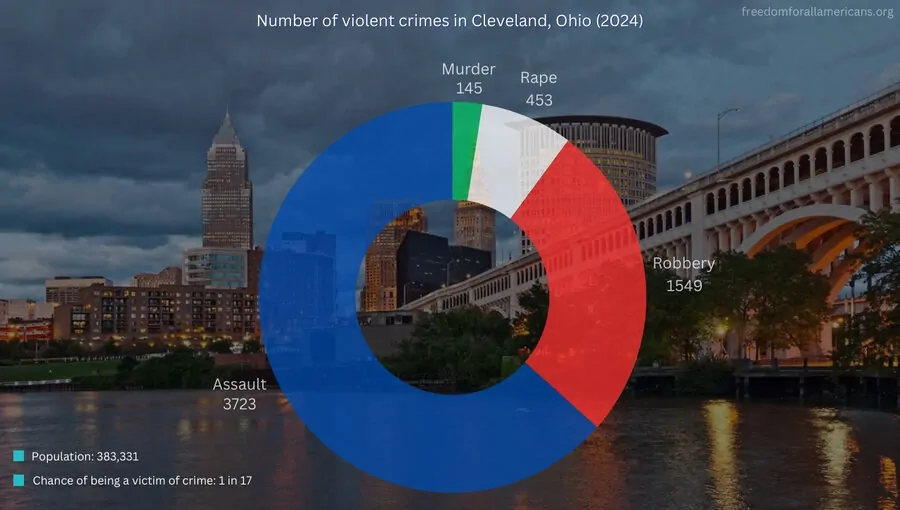
Cleveland, the second most populous city in Ohio, has a crime rate of 59.31, which makes it one of the most dangerous in America.
Cleveland crime rate is 155% higher than the national average.
Factors such as poverty, unemployment, and gang activity are prevalent, with specific crime statistics highlighting a high number of homicides, assaults, and robberies.
- Population: 383,331
- Violent Crimes: 5,870
- Property Crimes: 15,704
- Total Crimes: 21,574
- Chances of Becoming a Victim: 1 in 17
Efforts to combat crime in Cleveland must therefore be multifaceted.
Enhanced policing strategies, including increased patrolling, community policing initiatives, and the use of technology such as CCTV and data analytics, are crucial.
Addressing the socio-economic drivers of crime through community development projects, improved educational opportunities, job creation, and social services can provide long-term solutions to reduce crime rates, Cleveland.com reports.
Tackling gang violence through targeted interventions, including collaboration between law enforcement agencies, community groups, and social service providers, is essential, Cleveland19 reports.
Such initiatives should focus on gang prevention programs, conflict resolution, and rehabilitation services, aiming to divert potential and current gang members toward more productive and lawful activities.
- Burglary: 3,005
- Theft: 8,800
- Motor Vehicle Theft: 3,974
Cleveland.com also reported that in 2024, the city witnessed a massive increase in violence, and this is probably the most important reason why Cleveland is so dangerous in some of its neighborhoods.
RISE Initiative Looked Successful at the End of 2024
According to the City of Cleveland, the city’s “Raising Investment in Safety for Everyone” (RISE) initiative, launched in July 2023, has been instrumental in the decline of crime. Over a 500-day period ending December 1, 2024, the initiative reported the following decreases:
- Homicides: 35.8% decrease
- Grand Theft-Motor Vehicles: 22.2% decrease
- Felonious Assaults: 9.1% decrease
- Robberies: 8.6% decrease
- Burglaries: 4% decrease
Common Factors Among the Most Dangerous Cities in Ohio
The most dangerous cities in Ohio share several underlying socio-economic conditions that create environments conducive to crime.
High poverty and unemployment rates stand out as the most significant contributors, directly correlating with higher incidences of crime.These economic challenges reduce opportunities for legitimate income, pushing more individuals towards illegal activities as a means of survival.
Drug-related issues, particularly the opioid crisis, further exacerbate the crime landscape. Ohio’s intense struggle with opioid addiction has not only fueled an increase in drug-related crimes but also in violent and property crimes.
The crisis has put a severe strain on community resources, overburdening social services and healthcare systems, and thereby compounding the challenges in these areas.
Law enforcement agencies in these regions encounter numerous obstacles. The combination of limited budgets and manpower makes it difficult to enforce laws effectively and to implement proactive crime prevention strategies.
The strained relationship between police and communities—often worsened by incidents of misconduct and perceived injustices—makes it harder to foster the cooperation needed for successful policing.
At @Citi headquarters, NYPD & security presence outside is steadily growing ahead of a planned demonstration where climate activist John Mark Rozendaal is expected to play his cello in the plaza in violation of a restraining order pursued against him to inhibit protest activity. pic.twitter.com/NSULX8qYfn
— Talia Jane ❤️🔥 (@taliaotg) August 8, 2024
Trust is essential, and without it, even well-intentioned efforts can falter.
Methodology
For analysis of Ohio’s crime rate, I rely on the crime data annually published by reputable sources, like NeighborhoodScout and AreaVibes, which use data collected from government sources.
This data is released in two key segments: a preliminary overview focused on the nation’s largest cities, followed by a detailed year-end report.
- Per Capita Violent Crime Rates
- Per Capita Property Crime Rates
In pursuing a nuanced examination, our study predominantly concentrated on the state of Ohio, to get a more rounded state-wide perspective.
The Bottom Line
The analysis of the most dangerous cities in Ohio for 2024 highlights significant challenges facing these areas, with crime rates substantially exceeding state and sometimes national averages.
Cities like Moraine, Whitehall, and Cleveland stand out with particularly high crime rates, influenced strongly by socio-economic factors such as poverty, unemployment, and lack of educational opportunities.
In cities like East Cleveland and Akron, the rates of violent and property crimes are alarmingly high, emphasizing the urgent need for comprehensive crime prevention strategies and community engagement.
Economic disparities, unemployment, and social instability contribute greatly to the prevalence of crime across the listed cities.
References
- areavibes.com – Cleveland, OH Crime Rates
- neigborhoodscout.com – Ohio Crime Rates and Statistics
- ycharts.com – Akron, OH Unemployment Rate
- bls.gov – Economy at Glance: Cincinnati-Middletown
- ojp.gov – Community Oriented Policing and Problem Solving
- wvxu.org – Violent crime in Cincinnati is at an all-time low, despite increased reports of rape, non-fatal shootings
- alliedacademies.org – The impact of socioeconomic factors on crime rates
- ymcacolumbus.org – Whitehall Before & After School Programs
- cleveland.com – DeWine to send state troopers to East Cleveland to beef up depleted police department
- fred.stlouisfed.org – Unemployment Rate in Toledo, OH
- talent.com – Average salary in Toledo, OH in 2024
- wdtn.com – Dayton ranked top 5 deadliest city in US: report
- justice.gov – Drugs and Crime City Profile: Dayton, Ohio
- daytondailynews.com – Dayton police officers quit, recruits drop out. Staffing issues worsen
- crainscleveland.com – Canton hopes to launch $100 million-plus workforce development effort
- cleveland19.com – Gang violence in Cleveland a high priority for FBI as Justice Dept. pushes steeper charges
- wkbn.com – Drug trafficking busts among largest in state history, Ohio attorney general says

